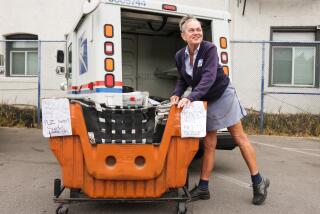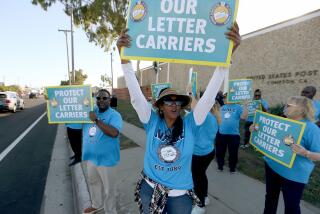Postal carrier heroics: Saving shooting victims and rescuing people from burning homes

Letter carrier Felipe Raymundo moves a tray of mail to his truck to begin delivery Monday, Dec. 5, 2011, at a post office in Seattle.
- Share via
Reporting from Washington — Not even a full month into his new job delivering mail, Scott Gallegos, an Iraq war Army veteran, found himself back in hostile conditions.
On April 27, Gallegos, filling in for a co-worker, was starting his morning route in Carmichael, Calif., when a bloodied woman startled him by banging on the door of his Postal Service vehicle.
She had been shot.
Then, while Gallegos applied pressure to the woman’s neck and stomach wounds with his shirt, gunshots rang out. He carried the woman to cover underneath nearby bushes, then drove her to the hospital.
“It was kind of intervention that I got that route that day and it happened at that exact time,” said Gallegos, 43, who celebrated the Fourth of July with the victim. “Everything just kind of fell right into place.”
The country’s largest postal union honored letter carriers Thursday who went beyond their job requirements. Many had served in the military, said Fredric Rolando, president of the National Assn. of Letter Carriers, as one-quarter of letter carriers have.
“Each incident required a level of courage, compassion, creative thought and action,” Rolando said. “Each individual rose to the occasion.”
Such as when veteran Denice Howard, a 30-year carrier in Planfield, N.J., found an elderly person who had fallen on ice. Or when Kizzy Spaulding of Akron, Ohio, and Steve Shipman of Tulsa, Okla., each rescued people from burning homes. And when Terrence Graves, a Navy combat veteran, and Bryce McLean spotted and detained a suspected thief in Eugene, Ore.
Others, like James Robledo of Garden Grove, a retired Vietnam veteran who teaches fellow veterans how to play guitar, and John Curtis, a retiree from Maine who wrote a booklet on past labor struggles, were honored with humanitarian and education awards, respectively.
“What I did that day is what I would like anyone to do for my daughter, son or anybody else,” said Alan Symonette, a 29-year carrier, who with a bystander pulled a driver from a sinking SUV in a Gainesville, Fla., pond. Afterward, the former Marine went back to delivering mail on his route.
Before 1916, letter carriers had to personally hand the mail to residents, who weren’t required to have mailboxes, according to the Smithsonian’s National Postal Museum.
Today, many Americans rarely see who delivers their letters and packages. Nonetheless, thousands of carriers not only deliver mail to 153 million homes and businesses, they sometimes risk their lives.
“One of my best acts as postmaster general is signing hero letters,” said Megan Brennan. “As Fred noted, it happens on a regular basis.”
Such award ceremonies are meant not only to encourage hardworking postal workers, but also to help brighten a struggling agency. A sharp decline in first-class mail usage and competition from the Internet are among the biggest problems faced by the Postal Service, mired in significant debt.
In a paper published in August, Elaine Kamarck, a Brookings Institute senior fellow, suggested the Postal Service be divided into two entities: a public agency dedicated to delivering mail, and privatized one to free it from regulations.
“Redefining the universal mandate for an information age will allow the United States to preserve it, and privatizing the rest of the organization will allow for fair competition in an already robust marketplace,” wrote Kamarck.
More to Read
Sign up for Essential California
The most important California stories and recommendations in your inbox every morning.
You may occasionally receive promotional content from the Los Angeles Times.










